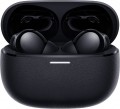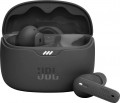Hi-Res Audio
Headphone support for Hi-Res Audio. The corresponding format is designed to provide a sound close to that recorded in the studio.
Hi-Res Audio refers to a digital signal with parameters from 96 kHz / 24 bits, and for analog technology, the requirement for an extended frequency response is set from 40 kHz. Audio tracks in this format sound as close as possible to the original ideas of the authors of the compositions. The Hi-Res license marks premium headphones for avid audiophiles.
Game mode (low input lag)
A special game mode in wireless headphones that minimizes the delay in transmitting an audio track from a connected source.
Low Input Lag) provides the ability to quickly respond to what is happening in virtual battles and prevents the picture from being out of sync with the sound. At the same time, when you activate the game mode, wireless headphones will be discharged faster.
Sensitivity
Rated headphone sensitivity. Technically, this is the volume at which they sound when a certain standard signal from the amplifier is connected to them. Thus, sensitivity is one of the parameters that determine the overall volume of the headphones: the higher it is, the louder the sound will be with the same input signal level and other things being equal. However, we must not forget that the volume level also depends on the resistance (impedance, see above); moreover, it is worth choosing “ears” for a specific device first by impedance, and only then by sensitivity. In this case, one parameter can be compensated for by another: for example, a model with high resistance and high sensitivity can work even on a relatively weak amplifier.
As for specific figures, headphones with indicators of 100 dB or less are designed mainly for use in a quiet environment (in some similar models, the sensitivity
does not exceed 90 dB). For use on the street, in transport and other similar conditions, it is desirable to have more sensitive headphones — about
101 – 105 dB, or even
110 dB. And in some models, this figure can reach
116 – 120 dB. and even
more.
It is also worth noting that this parameter is relevant only for a wired connection according to the analogue standard — for example, via a 3.5 mm mini-
...jack. When using digital interfaces like USB and wireless channels like Bluetooth, the sound is processed in the built-in headphone converter, and if you plan to mainly use this kind of application, you can not pay much attention to sensitivity.Speaker size
The diameter of the speaker installed in the headphones; models with multiple drivers (see "Number of drivers"), usually, the size of the largest speaker is taken into account, other dimensions can be specified in the notes.
In general, this parameter is relevant primarily for over-ear headphones (see "Design"). In them, emitters can have different sizes; the larger it is, the more saturated the sound is and the better the speaker reproduces the bass, however, large emitters have a corresponding effect on the dimensions, weight and price of the headphones. But in-ear "ears" and earbuds, by definition, have very small speakers, and rich bass in them is achieved due to other design features.
Number of emitters
The number of emitters installed in each individual earphone. Specified only for models with
more than one emitter.
The meaning of this feature depends on the type of emitters (see above). So, in hybrid models, by definition, there are several — the frequency range is distributed between them, which has a positive effect on the frequency response. For the same purpose, several reinforcing radiators can be used. And with the traditional dynamic principle of operation, due to several emitters, the effect of surround sound can also be provided (see "Sound").
Anyway, "ears" with numerous emitters, other things being equal, will be more advanced, but also more expensive.
Sensitivity
The sensitivity of the headphone's own microphone.
The more sensitive the microphone, the higher the signal level from it, at the same sound volume, and the better this model is suitable for picking up quiet sounds. Conversely, low sensitivity filters out background noise. At the same time, we note that these nuances are important mainly in professional work with sound. And for simple tasks like voice communication over the phone or via the Internet, sensitivity does not really matter: in headphones of this specialization, it is selected in such a way as to ensure that the microphone is guaranteed to work.
Microphone noise canceling
The presence of a noise reduction system in its own headphone microphone.
In accordance with the name, such a system is designed to eliminate extraneous noise - primarily during conversations. It is usually based on an electronic filter that passes the sound of a human voice and cuts off background sounds such as city noise, the rumble of wind in the microphone grille, etc. As a result, even in noisy environments, thanks to the
noise reduction of the microphone, speech is clear and intelligible; True, the system inevitably introduces distortions into the final sound, but they are not critical in this case.
— ENC. ENC (Environment Noise Cancellation) technology significantly reduces ambient noise with directional microphones. It is used both in gaming devices so that gamers can easily communicate in voice chat, and in TWS earphone models so that you can comfortably talk on the phone in a noisy environment.
— cVc. Microphone noise reduction cVc (Clear Voice Capture) is an advanced technology that is found mainly in expensive headphone models. cVc algorithms effectively suppress echo and noise from the environment. Sound processing using this technology is carried out at several levels at once - the algorithm determines the reference signal-to-noise level, automatically adjusts speech to the desired volume level, applies adaptive equalizers to process the entire voice, as well as specialized filters to remove
...low-frequency bubbling, sibilants and hissing.Mobile app
The ability to operate the functions and settings of headphones through
a mobile application for a smartphone or tablet. Communication between the device and gadgets is usually carried out via the Bluetooth wireless protocol. The mobile application may provide tools for flexible sound settings (equalizer, bass boost, etc.), switching noise reduction and transparency modes, reassigning buttons and gestures, finding lost headphones, etc. Also, the ability to update the headphone firmware is often implemented through the mobile application.
Autopause
A function that allows you to automatically pause the playback track when you remove the headphones (or one headphone).
Autopause is found mainly in wireless models (see "Connection Type") true wireless format (see "Cable Type"); however, there are other types of headphones with this function — for example, with a combined connection and an overhead design. Anyway, the proximity sensor is usually responsible for the auto-pause operation, which is triggered when the earpiece moves away from the ear. This feature is especially useful in situations where, after removing the headphones, there is no time to manually pause playback — for example, you need to urgently respond to what is happening nearby. At the same time, some models are able to automatically resume playback when the earpiece is returned to its place, however, this function is not strictly required — it will not hurt to clarify its presence separately.

